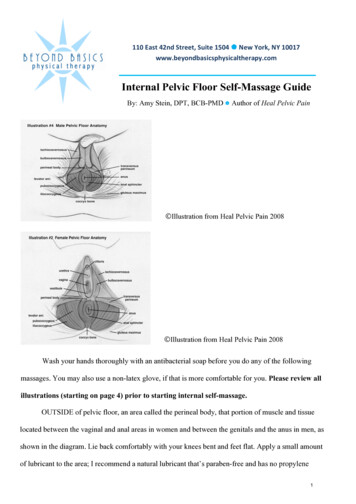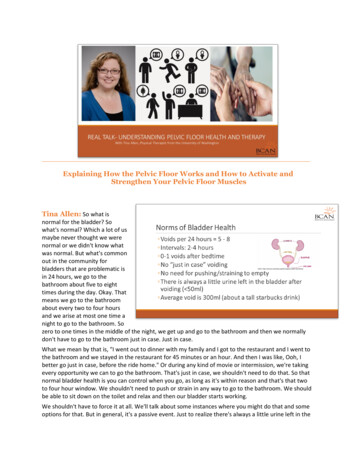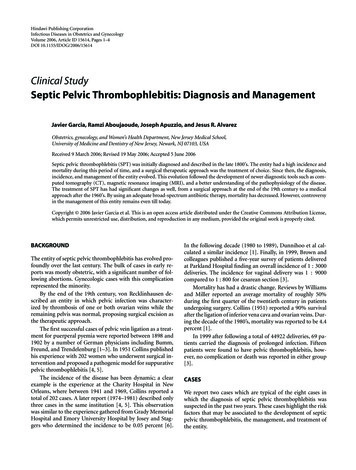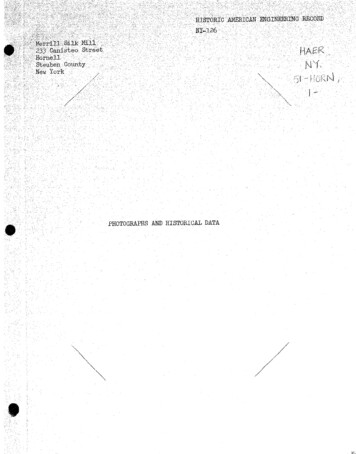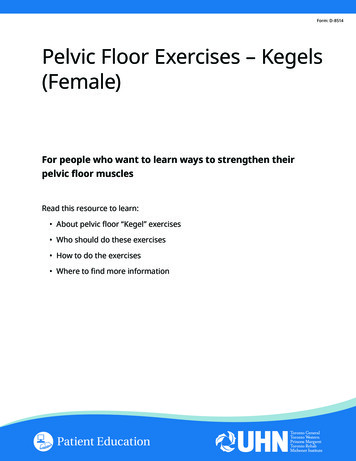
Transcription
Form: D-8514Pelvic Floor Exercises – Kegels(Female)For people who want to learn ways to strengthen theirpelvic floor musclesRead this resource to learn: About pelvic floor “Kegel” exercises Who should do these exercises How to do the exercises Where to find more information
About pelvic floor exercises or “Kegels”Pelvic floor exercises (also called Kegel exercises) are a simple way tohelp build strength in your pelvic floor muscles. These muscles form abowl shape in the base of your pelvis (see pictures below).Your pelvic floor muscles help you control the flow of urine (pee) andfeces (poo). They also keep your bladder, uterus and bowels in place.2
Who needs to do pelvic floor exercises?Women with weak pelvic floor muscles should do these exercises.You will likely have weak pelvic muscles if you: Leak urine or feces when you: laugh run cough lift something Have started menopause. Menopause is the time in life whenmenstruation (monthly period) stops. As menopause starts, the bodymakes less of the hormones that keep your muscles strong. Have had cancer treatments that cause early menopause.These include: chemotherapy radiation to the pelvis surgery to remove ovaries Are over the age of 40. Even if you have not gone through menopause,you should still start the exercises. As people age, their musclesnaturally get weaker. Had radiation therapy treatment near your pelvis. The treatmentmakes the muscles in the area tight and weak. Have given birth to a child. Carrying the weight of a baby for 9 monthscan cause the pelvic floor to stretch and weaken. Giving birth throughthe vagina can also cause the muscles to stretch, tear and become weak.3
Do not do pelvic floor exercises if you: Just had surgery. Wait at least 6 to 8 weeks before you do pelvic floorexercises. Your body needs time to heal. Talk to your doctor or nurseabout the right time to start these exercises. Have a urinary catheter in place. This is the tube doctors insertinto your urethra to collect pee in a bag. If you do the exercise with acatheter in place, you may cause bladder spasms or bleeding. You cando the exercises safely a few days after the catheter is removed. Askyour doctor or nurse about the right time to start these exercises. Feel pain during sex or medical pelvic exams. Doing pelvic floorexercises can make this pain worse. You will need to see a pelvic healthphysiotherapist to help you with this pain before doing any pelvic floorexercises. See page 7 to learn about referrals and how to find a pelvichealth physiotherapist near you.How will strong pelvic floor muscles help me?Building strong pelvic floor muscles will help you: Prevent urine or feces from leaking. You will have more control withstronger pelvic floor muscles. Keep the organs above your pelvic floor in the right place. You needstrong pelvic floor muscles to hold your organs in place. Weak muscleswill cause your organs to shift lower than normal. Have better blood flow to your pelvic area. This will help your vaginastay healthy. Make sex feel better. Better blood flow will help your vagina stay moist.Stronger muscles around your vagina will increase friction during sex.Both will make sex more comfortable and enjoyable.4
How to do pelvic floor exercisesWhat do I need to do before I start the exercises?You need to find your pelvic floor muscles before you start theexercises. There are 2 ways you can find your pelvic floor muscles.Try both options below to see which works best for you:Option 11. Imagine you are sitting on the toilet.2. Then, imagine that you are peeing.3. Now, imagine stopping the flow of your urine midstream. Themuscles you used to stop the flow of urine are the pelvic floormuscles.Option 21. Use a mirror to look at the areabetween your vagina and anus.2. Tighten the muscles around youranus. It should feel like you arepreventing the release of gas. Youshould see the area between yourvagina and anus lift up and intowards your body. These are yourpelvic floor muscles.5
How do I do pelvic floor exercises?Follow these steps to do pelvic floor exercises:1. Get into a comfortable position. You may find it easiest to do the exerciselying down. You can also sit or stand if you like.2. Tighten your pelvic floor muscles. Your belly, inner thighs and bumshould be relaxed.3. Hold for 5 to 10 seconds.4. Relax your pelvic floor muscles for 10 seconds.Repeat this exercise 5 times.When 5 times becomes easy to do, increase it to 10 times.How often should I do pelvic floor exercises?Do pelvic floor exercises 3 times every day. Try to include these exercisesinto your daily routine. This will help you remember to do them every day.Try doing the exercises while you are: In bed when you first wake up. You can also do them just before you goto sleep. During a commercial break of a TV show. You can do this while stillsitting on the couch. Waiting for something to cook in the microwave. Waiting in line at the grocery store.Your muscles will get stronger as you start to exercise them more.6
Where to find more informationTalk to your doctor or nurse if you: Have trouble doing your pelvic floor exercises. Your doctor, nurse orpelvic health physiotherapist can teach you how to do the exercises. Notice your urine or feces is leaking. Your doctor, nurse or pelvic healthphysiotherapist can help you manage this. Feel a lot of pain during sex or medical pelvic exams. Tell your doctor ornurse about this pain. You will need to see a pelvic health physiotherapist.Do not do any pelvic floor exercises, it will make the pain worse.How do I find a pelvic health physiotherapist?Contact the organizations below to find a pelvic health physiotherapist nearyou. You do not need a doctor’s referral to see a pelvic health physiotherapist.But, some private health insurance companies only cover the cost if you havea doctor’s referral. Check with your insurance company.College of Physiotherapists of Ontario375 University Avenue, Suite 901Toronto, Ontario, M5G 2J5Website: www.collegept.orgEmail: info@collegept.orgPhone: 1 800 583 5885Pelvic Health SolutionsWebsite: www.pelvichealthsolutions.caHave feedback about this document?Please fill out our survey. Use this link: surveymonkey.com/r/uhn-peVisit www.uhnpatienteducation.ca for more health information. Contact pfep@uhn.ca to requestthis brochure in a different format, such as large print or electronic formats. 2021 University Health Network. All rights reserved. Use this material for your information only. It does not replace advice from yourdoctor or other health care professional. Do not use this information for diagnosis or treatment. Ask your health care provider for adviceabout a specific medical condition. You may print 1 copy of this brochure for non-commercial and personal use only.Form: D-8514 Author: Lianne McCabe, Kelli Young and Dr. Sarah Ferguson Reviewed: 2021
exercises can make this pain worse. You will need to see a pelvic health physiotherapist to help you with this pain before doing any pelvic floor exercises. See page 7 to learn about referrals and how to find a pelvic health physiotherapist near you. How will strong pelvic floor muscles help me
